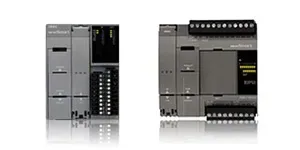Unlocking Efficiency: The Benefits of Using Programmable Logic Controllers (PLCs)

Why PLCs Are the Preferred Choice for Industrial Automation
Programmable Logic Controllers (PLCs) have become indispensable in the world of industrial automation. From manufacturing to utilities, PLCs offer a level of precision, flexibility, and reliability unmatched by traditional systems. As a PLC systems integrator, Electric Supply Source has seen firsthand the transformative impact of these devices on industries across El Paso County and Southern New Mexico. In this article, we explore why industries consistently turn to PLCs and delve into their numerous benefits.
Why PLCs Outperform Traditional Systems
Before the advent of PLCs, industrial automation relied on relay-based control systems, which were limited by:
- Complexity: Extensive wiring made installation and maintenance cumbersome.
- Inflexibility: Reconfiguring systems required significant time and labor.
- Unreliability: Susceptible to wear and tear, leading to frequent failures.
PLCs revolutionized industrial control by addressing these shortcomings. Their programmable nature and robust design offer solutions that make them the cornerstone of modern automation.
The Key Advantages of Using PLCs
- Flexibility and Programmability
- PLCs are designed to be easily reprogrammed, allowing industries to adapt quickly to changing production needs. Whether it's a new product line or a process adjustment, PLCs handle these transitions with minimal downtime.
- Scalability
- Modular designs make PLCs ideal for both small-scale operations and large industrial setups. Additional I/O modules can be integrated seamlessly as requirements grow.
- Reliability and Durability
- Engineered to operate in harsh environments, PLCs can withstand extreme temperatures, vibrations, and electrical noise. Their ruggedness ensures uninterrupted operation in demanding conditions.
- Efficiency and Speed
- PLCs process data and execute commands in real-time, significantly reducing delays and boosting overall productivity. Their ability to handle complex algorithms ensures optimal performance.
- Ease of Maintenance
- Diagnostic features built into PLCs simplify troubleshooting and maintenance. Technicians can identify and address issues quickly, minimizing downtime.
- Integration and Communication
- Modern PLCs support a variety of communication protocols, such as Ethernet/IP and Modbus, enabling seamless integration with other systems. This connectivity facilitates centralized monitoring and control.
- Cost-Effectiveness
- Although initial investment costs may be higher, the long-term benefits of reduced downtime, lower maintenance costs, and increased productivity make PLCs a cost-effective choice.
Real-World Examples of PLC Benefits
At Electric Supply Source, we’ve implemented PLC systems for diverse clients, ranging from food industries to electric utilities. Here are a few examples:
- Manufacturing: A client in the automotive industry improved their assembly line efficiency by 30% after replacing relay-based systems with PLCs.
- Oil and Gas: PLCs enabled real-time monitoring and control of pipeline operations, reducing response times during critical events.
- Food Processing: Automated conveyor systems powered by PLCs streamlined packaging processes, ensuring consistent quality and faster production.
How Electric Supply Source Optimizes PLC Systems
As a certified PLC systems integrator, Electric Supply Source specializes in optimizing complex control systems using PLC technology. Our expertise includes:
- SCADA Integration: Allowing operators to manage alarms and access real-time data remotely.
- Custom Programming: Developing tailored solutions for unique industrial challenges.
- System Upgrades: Modernizing legacy systems with the latest PLC advancements.
The Future of PLCs in Industrial Automation
PLCs continue to evolve, embracing new technologies to meet the demands of Industry 4.0. Trends include:
- IoT Integration: Enabling smarter factories through interconnected devices and real-time analytics.
- AI and Machine Learning: Leveraging predictive capabilities for maintenance and decision-making.
- Energy Efficiency: Designing systems that reduce energy consumption and environmental impact.
By staying ahead of these trends, Electric Supply Source ensures clients benefit from the latest advancements in PLC technology.
Conclusion
PLCs have redefined industrial automation, offering unmatched flexibility, reliability, and efficiency. From streamlining production lines to integrating cutting-edge technologies, their benefits are undeniable. At Electric Supply Source, we’re committed to delivering innovative PLC solutions that empower industries to achieve their full potential. Ready to explore the possibilities? Contact us today and discover how PLCs can transform your operations.
Other References
"Advantages and Disadvantages of PLC" by Automation Community
- This article discusses the reliability and flexibility of PLCs, highlighting their ability to operate in harsh industrial environments and be easily reprogrammed for various tasks. Automation Community
"What Are the Advantages PLCs Have over Relay Systems" by RealPars
- This piece explains how PLCs offer improved reliability, easier troubleshooting, and expandability compared to traditional relay systems. Learn Tomorrow's Skills
"Pros and Cons of PLCs in Industrial Automation" by AI Automation
- This resource examines the cost-effectiveness and scalability of PLC systems, noting that while initial costs may be higher, the long-term benefits justify the investment. AI Automation
"Introduction to Programmable Logic Controllers (PLCs)" by IIPD Global
- This comprehensive guide provides an overview of PLCs, their components, and their significance in industrial automation, offering insights into their role in modern manufacturing processes. IIPD Global
Key Takeaways
- Flexibility: PLCs adapt quickly to changing production needs with minimal downtime.
- Scalability: Modular designs allow for seamless integration of additional components.
- Reliability: Rugged designs ensure uninterrupted operation in harsh conditions.
- Efficiency: Real-time processing boosts productivity and reduces delays.
- Ease of Maintenance: Diagnostic tools simplify troubleshooting and minimize downtime.
- Cost-Effectiveness: Long-term savings outweigh initial investment costs.
- Integration: Advanced communication protocols enable centralized monitoring and control.
- Future-Ready:
- Emerging technologies like IoT and AI are shaping the next generation of PLCs.


